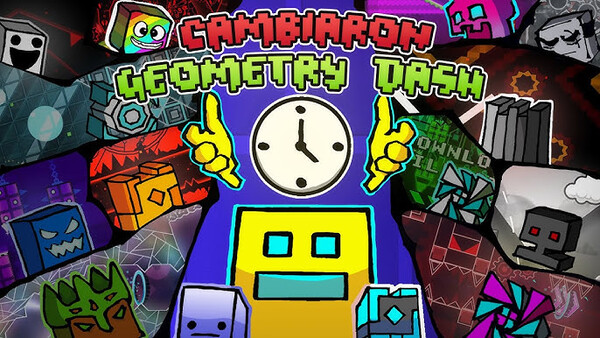Introduction
Geometry Dash is a rhythm-based platformer that challenges players to navigate through complex levels filled with obstacles and timed jumps. The game’s fast pace, coupled with challenging level design, makes it a test of patience, timing, and precision. In this article, we’ll explore step-by-step strategies on how to improve your skills, master difficult levels, and achieve success in Geometry Dash. From fundamental tips to advanced techniques, this guide covers everything you need to elevate your game.
Understanding the Basics of Geometry Dash
To begin mastering Geometry Dash, it’s essential to understand its mechanics and gameplay elements. The game features rhythmic gameplay where players must jump, slide, and avoid obstacles to the beat of the music.

To begin mastering Geometry Dash, it’s essential to understand its mechanics and gameplay elements
Game Mechanics and Controls
Geometry Dash’s controls are simple but require precision. Players tap to jump and release to avoid spikes, hazards, and obstacles. Knowing when to tap and hold is crucial for navigating levels smoothly.
Familiarizing Yourself with Game Modes
The game has various modes, including Practice Mode and Challenge Mode. Practice Mode helps you familiarize yourself with levels without penalties, while Challenge Mode tests your endurance on difficult stages.
Developing Timing and Rhythm Skills
Geometry Dash relies heavily on timing and rhythm, as each level’s jumps and movements are synchronized with its music. Building timing skills will help you move fluidly through challenging stages.
Practicing Timing with Simpler Levels
Start with simpler levels to practice timing, paying close attention to the beats and the game’s rhythm. This will develop your ability to anticipate jumps and obstacles based on sound cues.
Advanced Timing Techniques for Complex Levels
Once you’re comfortable with basic timing, practice in levels with varying speeds. These require you to adjust your timing mid-game, which can improve your adaptability to any level’s rhythm.
Mastering Obstacles and Hazards
Geometry Dash levels are full of obstacles, including spikes, rotating blades, and moving platforms. Each obstacle type requires a different approach to conquer.
Analyzing Obstacles by Type
Each obstacle requires specific timing. Spikes, for example, need quick taps, while rotating blades require delayed jumps. Observing and understanding each obstacle type will help you adapt effectively.
Creating a Strategy for Difficult Obstacles
Some levels feature obstacles that are placed in succession, demanding consecutive jumps. Practice linking your jumps to improve your performance in these challenging sections.
Practicing in Practice Mode for Consistency
Practice Mode allows you to place checkpoints throughout levels, helping you break down difficult parts. This mode is essential for learning without the risk of having to restart the entire level.
Setting Checkpoints Wisely
In Practice Mode, set checkpoints before challenging parts to repeat them until perfected. This helps you gain muscle memory for those tricky sections.
Leveraging Practice Mode for Tricky Sections
By practicing repeatedly in Practice Mode, you can fine-tune your skills for difficult sections, gradually increasing your completion rate and decreasing retries.
Level Progression: Moving from Easy to Hard
A great way to improve in Geometry Dash is by gradually progressing from easier to harder levels. This builds foundational skills that can be applied to more difficult stages.
Starting with Official Levels
The official levels provided by the game are designed with progressive difficulty. Start with these to learn the basics, then work your way to harder levels to steadily improve.
Choosing User-Created Levels
Once you’re confident with official levels, explore user-created levels, which often contain unique challenges. These levels broaden your skills and expose you to various gameplay elements.

Once you’re confident with official levels, explore user-created levels, which often contain unique challenges
Using Coins and Achievements to Stay Motivated
Earning coins and achievements provides a sense of accomplishment. These rewards not only track progress but also unlock new character skins and colors.
Collecting Secret Coins
Secret coins are hidden in levels and offer a challenge to players seeking completion. These coins also unlock rewards, adding an extra layer of motivation.
Unlocking Achievements
Achievements are milestones that can be earned for completing levels, collecting coins, and reaching high scores. Tracking these motivates players to improve and tackle harder levels.
Developing Muscle Memory for Advanced Levels
In Geometry Dash, muscle memory is essential. Once you’ve mastered certain parts of a level, your muscle memory can take over, reducing stress and improving consistency.
Repetition for Familiarity
Playing levels repeatedly creates familiarity. For difficult levels, repeat the same sections until your fingers move instinctively, which reduces reaction time.
Building Muscle Memory Through Practice Mode
Using checkpoints in Practice Mode allows you to repeat sections until they feel effortless. Muscle memory helps in challenging levels, where quick reflexes are essential.
Understanding Speed Changes and Adapting
Geometry Dash levels often feature speed changes, which alter the rhythm and timing required for jumps. Adapting to these changes is key for progressing in harder levels.
Recognizing Speed Triggers
Speed triggers adjust your character’s pace. Observe these triggers in Practice Mode to understand how they affect timing, and adjust your rhythm accordingly.
Practicing Speed Variations
To master speed changes, practice in levels with varying speeds. This will improve your ability to adapt to unexpected changes in pacing and rhythm.
Leveraging Community Resources for Improvement
The Geometry Dash community is filled with resources, from forums and tutorials to gameplay videos. Engaging with these resources offers insight into strategies used by other players.
Watching Gameplay Videos
Gameplay videos, particularly of challenging levels, reveal techniques that top players use. Observing these videos can inspire you and provide useful tips for mastering tough levels.
Engaging in Forums and Discussions
Forums like Reddit or dedicated Geometry Dash communities allow players to share tips and level codes. Connecting with other players opens new avenues for learning.
Setting Personal Goals for Long-Term Improvement
Personal goals help keep you motivated and focused on continuous improvement. By setting achievable targets, you can measure your progress and push yourself further.
Defining Goals Based on Skill Level
Setting realistic goals, such as completing a certain number of levels per week or mastering specific jumps, keeps your motivation high and your progress steady.
Tracking and Celebrating Achievements
Celebrate small victories, such as beating a level with no deaths or collecting all coins in a stage. Tracking achievements helps reinforce your improvement over time.

Celebrate small victories, such as beating a level with no deaths or collecting all coins in a stage
Conclusion
Mastering Geometry Dash is a journey that combines rhythm, timing, and precision. By understanding game mechanics, using Practice Mode effectively, and gradually tackling more challenging levels, players can improve their skills and tackle even the most daunting levels. Remember to stay motivated, use community resources, and set personal goals to measure your progress. With practice and perseverance, any player can master Geometry Dash’s thrilling challenges.


